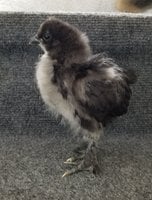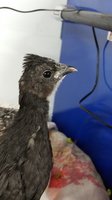Courtburr
Chirping
- Oct 25, 2018
- 50
- 46
- 56
I had posted about this black mix and a barred rock that I got at 2 weeks old. As the black one has matured a bit more and I've done hours and hours of research, I'm down to thinking this is a silkie/cochin mix. The farm the egg came from says her dad has white silkies (hens and roosters) and a blue cochin rooster. While they say they're kept separate, I'm not ruling anything out.
All that being said, from a genetics standpoint, could a white silkie hen and blue cochin rooster even produce a black offspring like this? I've read somewhere that there are two white silkie genes and only one will ensure all white offspring. I'm not sure on the blue cochin genes though and if that could bring about black with the non-white white (not sure what else to call it) silkie gene.
I'm adding a few different age pics to hopefully help with some of its characteristics....3, 5 and 7 weeks. It's about 7.5 weeks now.
All that being said, from a genetics standpoint, could a white silkie hen and blue cochin rooster even produce a black offspring like this? I've read somewhere that there are two white silkie genes and only one will ensure all white offspring. I'm not sure on the blue cochin genes though and if that could bring about black with the non-white white (not sure what else to call it) silkie gene.
I'm adding a few different age pics to hopefully help with some of its characteristics....3, 5 and 7 weeks. It's about 7.5 weeks now.





